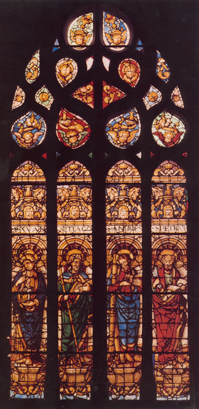12 March 2008
Global Seminars & Invited Speaker Series
DECORATIVE ARTS AND ARTISTIC TECHNIQUES
The Renaissance stained glass window and Pamplona Cathedral
Dr. Víctor Nieto Alcaide.
Full Professor of the UNED of Madrid and Academic
The first forms of the Renaissance appear in Spanish stained glass around 1500 through the framing elements. Some of them imitate "Roman" forms, such as arches, venerated vaults and other decorative motifs such as grotesques. The forms, on the other hand, remain attached to the Flemish system of representation, as does the elaborate technique.
It was the active workshops around the turn of the century that initiated the transformation of the language as, for example, the Burgos of Arnao de Flandes the Elder and Diego de Santillana. In them other glassmakers were formed in whose work the forms of the Renaissance appear as an assimilated language in all its aspects (Arnao de Vergara and Arnao de Flandes, Juan del Campo and Hernando de Labia).
However, in the mid-sixteenth century, when it was decided to start the great programs of stained glass for new cathedrals (Segovia, Granada, Salamanca) and the realization of new ones for buildings built some time ago, as in the case of the cathedral of Pamplona, several Flemish workshops appeared that displaced the Spanish workshops in the realization of the programs designed for the new buildings. For these, from different approaches, programs dedicated to the topic of the Redemption were made. Thus it appears in the programs of the cathedrals of Segovia, Granada and Salamanca.

Arnao de Flandes, "St. John, St. James, St. Andrew and St. Peter", 1543.
Seville Cathedral
The Renaissance stained glass windows of the cathedral of Pamplona were part of an iconographic cycle that, as evidenced by the theme of those preserved, developed this theme. The program was either never completed or, as seems most likely, has largely disappeared. They are stained glass windows in which the workshop that executed them had to adapt large compositions to windows divided by mullions typical of an earlier architecture of the building. In them there is a clear tendency to frame the different compositions with Renaissance architectural and decorative elements, such as the Annunciation or the Flagellation. The figures show accentuated features and great expressiveness because they were designed to give the religious image, which was perceived by the faithful from a great distance, an intense effectiveness, since they were made as part of a program of exegesis at a time of religious confrontation between Catholicism and Protestantism.

Anonymous, "The Flagellation", second third of the 16th century.
Pamplona Cathedral
